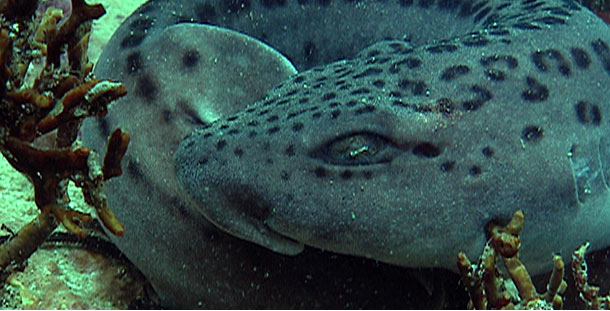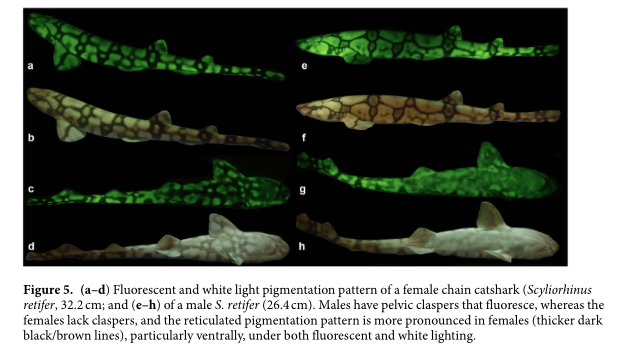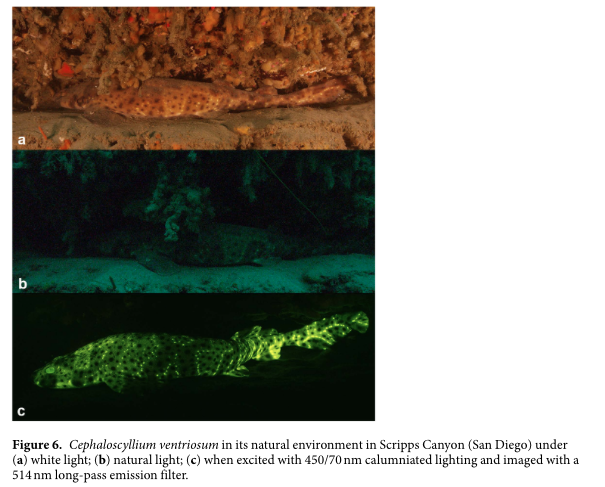Catsharks are warm water dwelling sharks that tend to live near coral reefs and along the ocean floor, though some species prefer environments of greater depth. They are smaller sharks and grow to be a little over two feet long, and as their name suggests, their eyes have a ‘cat-like’ appearance. These sharks, along with other relatives, have been known to exhibit green fluorescence.
Marine animals can fluoresce light at a specific depth threshold. This is done by absorbing the abundant ambient blue light that penetrates the water and then reemitting that energy at a longer and lower energy wavelength. This then produces colors that are perceived by humans as green, orange or red light. As the depth increases, the amount of available light decreases and the type of light becomes restricted, and fluorescent light becomes more discrete. Catsharks have specific visual pigments in their eyes that can detect fluorescent patterns against certain backgrounds.
Few studies have been done to investigate how this fluorescence appears to a shark’s conspecifics. Researchers (Gruber et al. 2016) examined two types of Catsharks, Cephaloscyllium ventriosum, and Chain Catshark Scyliorhinus retifer, whom occupy lower depths than other catsharks, and looked at their spectral sensitivity and visual characteristics, and how they perceived the fluorescent properties of their conspecifics in blue water.
They first conducted numerous skin analyses to determine what areas of the skin produced fluorescent emittance. They found that fluorescence is emitted from both dark and light patches on skin, and that lighter pigmented areas primarily produce a green emission spectrum, while darker patches produced a blue emission spectrum. This finding suggests that there are either two compounds, or that same compound in two different chemical forms, that are responsible for the fluorescent properties.
To demonstrate the sharks’ perception of fluorescence in conspecifics, they performed hyper spectral imaging of the sharks’ skin to investigated how the green-dominated fluorescence affected their appearance in regards to their environment. They also created a ‘shark-eye’ camera, that imitated the filters, spectral absorbance, and spectral sensitivity of the sharks, based on their monochromatic, slightly green shifted visual sensitivity.
This was done by fitting three lens filters on the camera while keeping the blue channel channel open. To imitate their environment, researchers calculated the dominant ambient light color and irradiance in the shallow depths, and recreated these settings in an aquarium. They also investigated different light conditions;
white light, natural light, and specific wavelengths that would excite the fluorescent patches in the skin. As can be seen from the images below, the patches are discrete to both human visual systems and the perceive shark visual system.
The study aimed to investigate the properties of Cephaloscyllium ventriosum and Scyliorhinus retifer, how they fluoresce, and how tho fluorescence is perceived by their conspecifics. There is no indication as to what this perceptions entail, and whether it is useful in mate detection, territorial claim, or general identification of conspecifics. In the future, research should be done to investigate the behavioral components related to biofluorescence in Catsharks.
Gruber, David F., Loew, Ellis R., Deheyn, Demetri D., Akkaynak, Derya, Gaffney, Jean P., Smith, W. Leo, Davis, Matthew P., Stern, Jennifer H., Peiribone, Vincent A., Sparks, John S., “Biofluorescence in Catsharks (Scyliorhinidae): Fundamental Description and Relevance for Elasmobranch Visual Ecology.” Nature. 2016. Sci. Rep. 6(24751). doi: 10.1038/srep2475.
“Sharkland: Catsharks.” PBS, 2008. Web. May 9, 2016.



